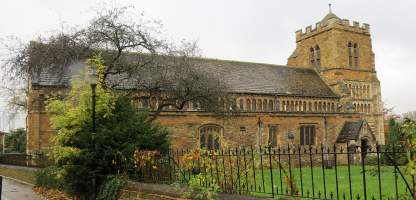 St Peter's Church, Northampton.
St Peter's Church, Northampton.
 St Peter's Church, Northampton.
St Peter's Church, Northampton.
St Peter’s Northampton is an ancient church, supposed to have been erected about the same time as Northampton Castle was built by Simon de Senlyz, first earl of Northampton, in 1075. It situated on the edge of the town, on the natural walking route from the railway station into the centre. It is a long, low church with a short, squat tower, largely faced in the beautiful orangey brown local stone which is characteristic of the town, most evocative. The long line of blank windows, the odd and apparently purposeless buttresses, which would seem to serve no structural purpose, and the interesting arch at the end under the tower (see picture near the bottom of this page), with its crumbling decorations, all point to something rather unusual. The inside is filled with Norman arches, with alternately clustered pillars and single ones, which separate the nave from the aisles. It is the capitals of these pillars which are a surprise, for they bear Saxon carvings. Those near the entrance of the church are mostly geometric and with lesser ornament, and could be excused as Saxon workmen working for Norman masters, perhaps, but as we progress along the nave we see strange beasts, vigorously carved in high relief, which are so individualistic and assured that (though I have no particular knowledge of the art of that period) it would be hard to credit them to other than a Saxon church for Saxon times. The church guardians when I visited suggested they were likely from the Saxon church, reused in the Norman replacement, which seems entirely reasonable. Also in the church is a single great grave slab, dated to 10th-11th C, also understood to be from the previous church, and attributed, the label says, to St Ragenar, a Saxon noble killed by Vikings in 870, giving rise at one time to a costly shrine. We see a tall slab with swirling leafy Saxon patterns in relief, with the image of a face (a Green Man), a bird, and some animals variously identifiable. A strange and remarkable piece.
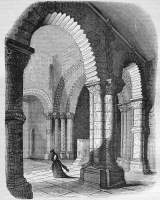
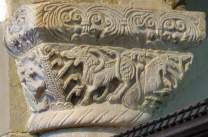 Interior of St Peter's church showing the Norman arches, and Saxon capital.
Interior of St Peter's church showing the Norman arches, and Saxon capital.
We should mention the woodwork, with presumably 18th or 19th C divisions of part of each aisle, and some of the monuments are thus fenced off from the main body of the church.
On to these monuments then. We have 20-odd panel monuments and one memorial bust, the majority from the 18th Century, half a dozen from the 19th Century, and one from 1914. As well as the bust, the collection incorporates a few carvings of winged cherub heads, and the styles of the monuments show a variety of classical panels with pilasters and summit pots etc, compositions based on the pyramid, and one in the style of a hanging drape. Several are signed, and we have work by the eminent sculptor Matthew Noble, an equally or more eminent monumental sculptor Robert Blore, and good examples of the Northampton School as represented by Henry and William Cox, John Hunt, and the less exciting John Whiting. The collection is complementary to that in the Parish Church, which is generally open, and which contains further examples of the work of these Northampton men.
We start with the several monuments to two 18th century families, and then proceed to note the rest in customary date order.
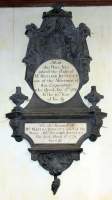 The unusual monument to Richard Jeffcutt and his wife, Martha.
The unusual monument to Richard Jeffcutt and his wife, Martha.
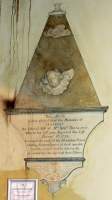 Harriot Treslove, d.1778, monument in manner of Henry Cox.
Harriot Treslove, d.1778, monument in manner of Henry Cox.
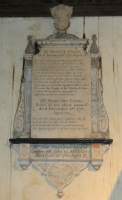 George Evans Monument, 1757, example of work of Henry Cox.
George Evans Monument, 1757, example of work of Henry Cox.
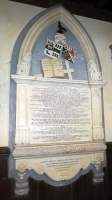 Robert Blore's monument to Revd. Edward Lockwood, d.1802;
Robert Blore's monument to Revd. Edward Lockwood, d.1802;
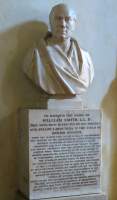 Matthew Noble's bust of William Smith, Geologist.
Matthew Noble's bust of William Smith, Geologist.
We may note aside from the monuments, the altar piece itself, and the mural decoration on the wall behind, in a sort of William Burgesque fashion, quite effective without detracting from the Norman character of the church. As well, near the door is a modern mosaic of St Peter, we must presume, done in the modern Greek style with an assured treatment of the face, and using Italian smalti.
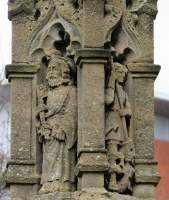 Figures of St Peter and St George on the war memorial.
Figures of St Peter and St George on the war memorial.
Outside, we have already noted the curious arch. A couple more bits of sculptural interest:
The engraving above, from the 1850s, is pleasingly comparable with the modern photo from the top of this page. There is some sort of leanto construction to the left of the pucture which has gone now, and the little cross at that end of the roof, but otherwise it has not been further touched. What has changed since then is that the numerous gravestones that dotted the grass around the church have been moved, and the backdrop of modest houses has been altered.
St Peter's Church in Northampton is vested in the estimable Churches Conservation Trust, whose website is found here.
Half a mile's walk out of Northampton is Hardingstone, and along the way stands one of the three surviving Eleanor Crosses with interesting medieval sculpture (see this page), and further away but still in Northamptonshire is Geddington, where the second surviving Cross is (see this page for Eleanor Crosses).
Northampton // Sculpture in some English towns
Sculpture pages // Introduction to church monuments
Visits to this page from 13 Mar 2014: 7,497